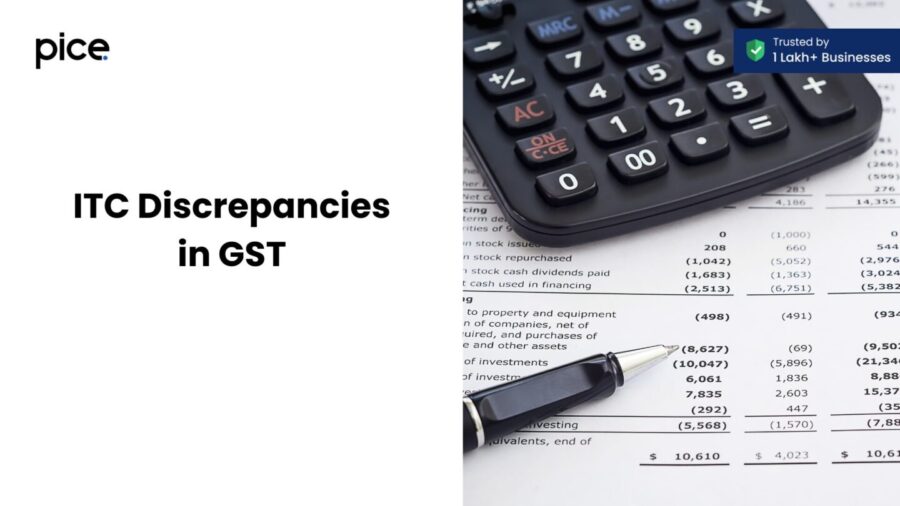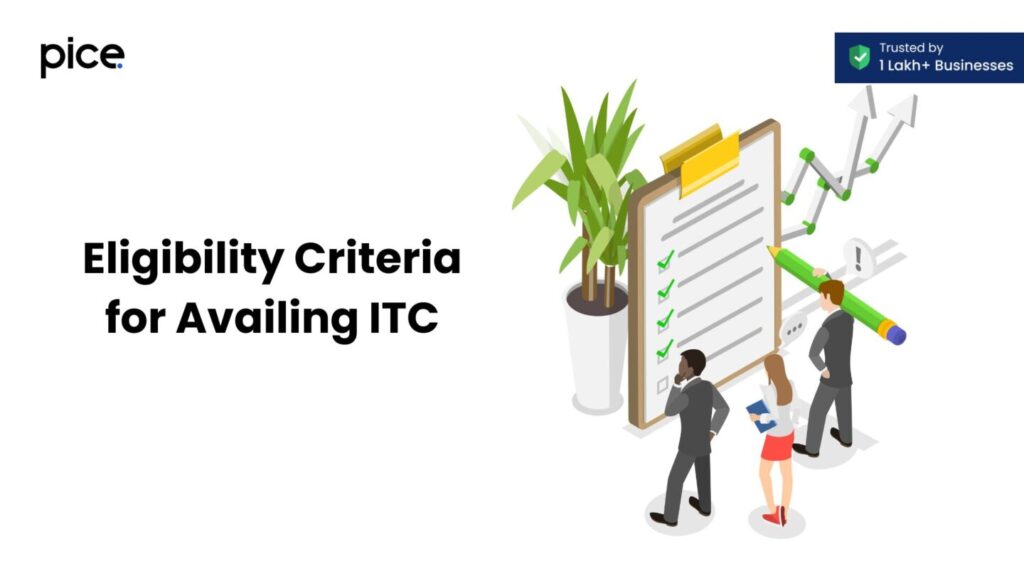ITC Discrepancies in GST
- 26 Aug 24
- 12 mins

ITC Discrepancies in GST
Key Takeaway
- Proper management of Input Tax Credit (ITC) is essential for optimizing the Output Tax Liability and ensuring accurate secretarial compliance.
- Only registered persons with eligible credit can claim ITC, which must be used in the course or furtherance of business to optimise ITC.
- To avail ITC, businesses must have valid tax invoices, pay the relevant tax, and meet all compliance requirements to ensure the availability of credit.
- Regular reconciliation of ITC claims with supplier data helps in identifying and addressing discrepancies, thereby preventing penalties and ensuring the reclaim of credit.
- Advances in technology and GST reforms are expected to enhance the process of ITC reconciliation, making it easier to manage credit in favour of businesses.
Understanding ITC in GST
Input Tax Credit (ITC) is a crucial aspect of the Goods and Services Tax (GST) regime, allowing businesses to reduce their tax liability on outward supplies by claiming credit for the taxes paid on inputs. This system ensures that the tax is levied only on the value addition at each stage of the supply chain, preventing the cascading effect of taxes. The concept of ITC facilitates seamless credit flow, thereby optimizing the overall tax burden on businesses.
To avail ITC, a registered person must meet certain conditions and maintain proper documentation. ITC can be claimed on various goods and services used in the course of business, provided they are not used for exempt supplies or personal purposes. The amount of ITC claimed must be reflected accurately in the GST returns, such as FORM GSTR-1 and GSTR-3B. The electronic credit ledger is used to record and manage ITC claims, ensuring that businesses have a clear and transparent record of their credits and liabilities.
The GST compliance framework requires businesses to regularly reconcile their ITC claims with the details provided by their suppliers. This process involves matching the ITC recorded in the purchase register with the information available in GSTR-2A and Form GSTR-2B. Any discrepancies identified must be rectified promptly to ensure accurate reporting and avoid penalties. The proper officer has the authority to verify ITC claims and demand documentation to support the claims made.
ITC plays a significant role in maintaining business compliance under GST. By ensuring that correct input tax credits are claimed and utilized, businesses can optimize their tax payments and improve cash flow management. The use of reconciliation tools and ERP e-TDS return filing solutions can streamline the ITC claim process and reduce the risk of discrepancies.
Eligibility Criteria for Availing ITC

To avail ITC under GST, businesses must meet specific eligibility criteria set forth by the GST laws. Firstly, the claimant must be a registered person under GST. This means the entity must have a valid GST registration and must be filing regular returns, such as FORM GSTR-1 and GSTR-3B, to report their outward supplies and input credits.
The goods or services on which ITC is claimed must be used in the course or furtherance of business. This includes goods purchased for resale, inputs used in the manufacturing process, and services availed for business operations. ITC cannot be claimed on goods or services used for personal purposes or exempt supplies. Additionally, ITC on certain items like motor vehicles, unless used for specific purposes, is restricted.
Another crucial criterion is the possession of a valid tax invoice or debit note issued by a registered supplier. This document must contain all the necessary details, such as the GSTIN of the supplier and recipient, the value of goods or services, and the tax amount charged. The invoice must be maintained in the books of accounts as evidence for claiming ITC.
The GST law mandates that the tax charged by the supplier must be paid to the government, and the return in FORM GSTR-3B must reflect this payment. This ensures that ITC is only claimed on tax amounts that have been deposited with the authorities. The payment of invoices to suppliers must be made within 180 days from the date of the invoice; otherwise, the claimed ITC must be reversed.
Businesses must also ensure that the ITC claimed is reported accurately in the electronic credit ledger and that any discrepancies between GSTR-2A and the purchase register are reconciled promptly. Regular reconciliation helps in maintaining compliance with GST norms and avoiding penalties for incorrect claims.
Conditions for Availing ITC
Several conditions must be met to avail ITC under GST. Firstly, the claimant must possess a valid tax invoice, debit note, or other prescribed document issued by a registered supplier. This document must be in the name of the registered person claiming ITC and should comply with the invoice requirements as per GST law.
The goods or services must have been received or deemed to be received by the claimant. In cases where goods are received in lots or installments, ITC can be claimed only upon receipt of the last lot or installment. For services, the requirement is that the services should have been rendered to the claimant.
The claimant must have paid the tax charged on the invoice to the supplier, and the supplier must have deposited the tax with the government. This is verified through the common portal where the claimant's GSTR-2A matches with the supplier's GSTR-1. Any mismatch between these returns can lead to discrepancies and affect the ITC claim.
Another condition is that the ITC must be claimed within the stipulated time frame. The GST law specifies that ITC must be claimed by the due date of filing the return for the month of September following the end of the financial year or the date of filing the annual return, whichever is earlier. Failure to claim ITC within this tax period results in the forfeiture of the credit.
The claimant must also ensure that the goods or services are used or intended to be used in the course or furtherance of business. ITC cannot be claimed on goods or services used for personal purposes or for making exempt supplies. Additionally, ITC cannot be claimed on blocked credits specified under Section 17(5) of the CGST Act, such as certain motor vehicles and services like health insurance.
Exploring ITC Discrepancies
ITC discrepancies arise when there is a mismatch between the ITC claimed by a registered person and the details provided by the suppliers in their GSTR-1. These discrepancies can lead to significant compliance risks and may result in penalties and interest on the excess credit claimed. Understanding the common reasons for these discrepancies and how to detect and rectify them is crucial for maintaining GST compliance.
Common Reasons for ITC Discrepancies
ITC discrepancies often occur due to errors in the invoices issued by suppliers or incorrect reporting in the GST returns. Common reasons include incorrect GSTIN of the recipient, mismatch in the invoice number or date, and differences in the tax amount. Suppliers may also fail to upload the invoice details in their GSTR-1, leading to a mismatch in the recipient's GSTR-2A.
Another common cause is the delay in the filing of returns by suppliers. If the supplier files their GSTR-1 late, the corresponding ITC may not appear in the recipient's GSTR-2A for the relevant tax period. This can result in discrepancies and affect the claim of credit. Additionally, discrepancies can arise if the recipient claims ITC on invoices that are not yet reflected in GSTR-2A.
Tools and Reports for Detecting Discrepancies

To detect ITC discrepancies, businesses can use various reconciliation tools and reports available on the GST portal and through third-party solutions. These tools compare the ITC claimed in the recipient's GSTR-3B with the details available in GSTR-2A and Form GSTR-2B. They help in identifying mismatches and provide detailed reports for further analysis.
The use of ERP systems and e-TDS return filing solutions can streamline the reconciliation process. These systems integrate with the GST portal to automatically fetch data and highlight discrepancies. Businesses can generate reports that detail the differences in invoices, tax amounts, and other relevant information, making it easier to communicate with suppliers for corrections.
Reconciling GSTR-2A with Purchase Register
Reconciling GSTR-2A with the purchase register is a crucial step in identifying and rectifying ITC discrepancies. This process involves matching the details of the invoices recorded in the purchase register with the data available in GSTR-2A. Any discrepancies found must be investigated and resolved by communicating with the concerned supplier.
Businesses should perform this reconciliation regularly, ideally on a monthly basis, to ensure that any discrepancies are detected early and rectified promptly. Using reconciliation tools can simplify this process and reduce the risk of errors. Proper documentation and timely follow-up with suppliers are essential to ensure accurate ITC claims.
GST Regulations on ITC Discrepancies
GST regulations mandate that any discrepancies in ITC claims must be rectified promptly to avoid penalties and interest. The proper officer has the authority to verify ITC claims and demand documentation to support the claims made. Failure to rectify discrepancies can result in the denial of ITC and imposition of penalties.
Deadlines and Penalties for Non-compliance
The GST law specifies strict deadlines for claiming ITC and rectifying discrepancies. ITC must be claimed by the due date of filing the return for the month of September following the end of the financial year or the date of filing the annual return, whichever is earlier. Failure to claim ITC within this tax period results in the forfeiture of the credit.
Non-compliance with the ITC regulations can result in penalties and interest on the excess credit claimed. The proper officer may also initiate audits and investigations to verify the ITC claims and ensure compliance. Businesses must maintain proper documentation and timely reconcile their ITC claims to avoid penalties.
Best Practices for Handling ITC Discrepancies
To manage ITC discrepancies effectively, businesses should adopt best practices such as regular reconciliation of GSTR-2A with the purchase register, timely communication with suppliers, and maintaining proper documentation. Using reconciliation tools and ERP systems can streamline the process and reduce the risk of errors.
Businesses should also train their accounting and finance teams on GST compliance and ITC regulations. Regular audits and reviews of the ITC claims can help in identifying discrepancies early and ensuring compliance with GST laws. Proper planning and timely action are crucial to managing ITC discrepancies effectively.
Future Prospects for GST Compliance and ITC Reconciliation
The future of GST compliance and ITC reconciliation looks promising with the advancement of technology and automation. The use of artificial intelligence and machine learning in reconciliation tools can enhance the accuracy and efficiency of the ITC claim process. These technologies can automatically detect discrepancies and provide real-time solutions for rectification.
The GST Council is also working on simplifying the ITC claim process and reducing the compliance burden on businesses. Future amendments may include more straightforward procedures for claiming ITC and resolving discrepancies. Businesses must stay updated with the latest developments in GST laws and leverage technology to optimize their ITC claims.
In conclusion, managing ITC discrepancies is crucial for maintaining GST compliance. By understanding the common reasons for discrepancies, using the right tools for detection and reconciliation, and adopting best practices, businesses can ensure accurate ITC claims and avoid penalties. The future prospects for GST compliance look bright with advancements in technology and regulatory reforms.
 By
By 
















